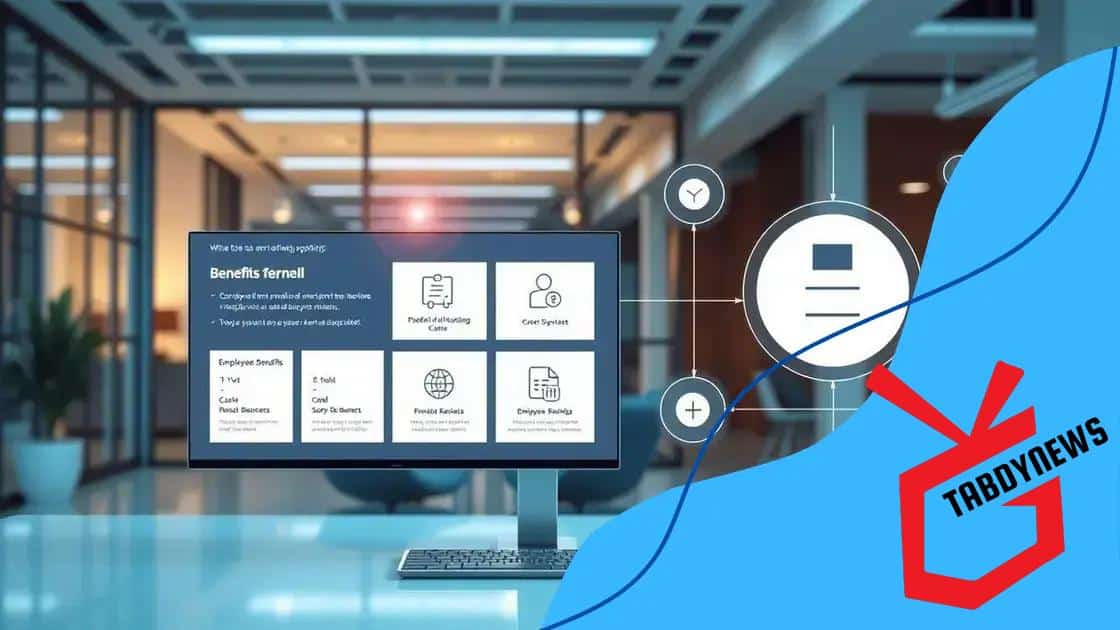Benefits enrollment digitization: transforming your experience

Benefits enrollment digitization streamlines the process of managing employee benefits through digital platforms, enhancing accessibility, personalization, and efficiency for both HR departments and employees.
Benefits enrollment digitization is changing how organizations approach employee benefits management. It offers a more efficient experience for HR teams and employees alike. Curious about how this transformation affects your workplace?
What is benefits enrollment digitization?
Benefits enrollment digitization refers to the modern process of managing employee benefits in a digital format. This transformation helps organizations streamline how they communicate and handle benefits information. By utilizing technology, companies can significantly improve efficiency and employee satisfaction.
Understanding the Basics
At its core, benefits enrollment digitization replaces traditional paper-based methods with digital interfaces. Employees can easily access their benefits information online, which saves time and reduces errors. Furthermore, this digitization allows for real-time updates and improvements in communication.
Key Features of Digitization
- Accessibility: Employees can view benefits on any device at any time.
- Real-time updates: Changes to benefits are immediately available.
- User-friendly interfaces: Employees find it easier to navigate and enroll in their benefits.
- Enhanced security: Digital systems often have stronger data protection measures.
This shift not only simplifies the enrollment process but also enhances overall experience by offering a more personalized approach. Companies that adopt digitization often report higher employee engagement and satisfaction, as well as a smoother workflow for HR teams.
Moreover, utilizing benefits enrollment digitization can significantly cut down administrative costs. Organizations no longer need to manage large amounts of paperwork, which can be both time-consuming and expensive. By transitioning to a digital platform, companies can allocate resources more effectively and focus on strategic initiatives.
In conclusion, benefits enrollment digitization is an essential step for any organization looking to improve its benefits management process. By embracing this technology, businesses can create a more efficient and satisfying experience for their employees.
Key advantages for HR departments
Digitalizing benefits enrollment brings numerous advantages that can significantly enhance the efficiency of HR departments. By transitioning to an automated system, HR teams can focus more on strategic initiatives instead of administrative tasks. This shift not only saves time but also improves overall productivity.
Streamlined Processes
One major advantage is the streamlined enrollment process. Instead of dealing with paper forms and manual entries, HR departments can rely on digital systems to organize data effortlessly. This reduces the risk of errors that often occur with paper-based approaches.
Improved Employee Experience
- Easy access to information: Employees can easily find details about their benefits at their convenience.
- Time-saving: The enrollment process becomes quicker, making it easier for employees to sign up.
- Self-service capabilities: Employees can make updates or changes without needing to contact HR.
Moreover, benefits enrollment digitization enhances communication between HR departments and employees. With real-time updates, HR can share important benefits information immediately, ensuring everyone stays informed. This transparency builds a trusting relationship between employees and HR, leading to higher engagement.
Digitization also allows HR departments to analyze data more effectively. By capturing enrollment trends and employee feedback, HR can quickly identify areas for improvement. This data-driven approach enables more effective decision-making regarding benefits offerings.
HR departments looking to attract and retain talent find that offering a smooth benefits enrollment experience is now crucial. The convenience of digital systems makes it easier for organizations to present themselves as modern and appealing to potential hires. As a result, employees feel more valued and their overall experience improves.
How to implement digitization effectively

Implementing benefits enrollment digitization effectively requires a thoughtful approach to ensure a smooth transition. By carefully planning the process, companies can maximize the advantages of digital solutions while minimizing potential challenges. It involves several key steps that all organizations should consider.
Assessment of Current Systems
The first step is to assess the current benefits administration process. Evaluate the strengths and weaknesses of the existing system. Understanding what works and what doesn’t can guide the digitization efforts. Engage with HR staff and employees to gather feedback on their experiences, which can reveal critical insights.
Choosing the Right Technology
- Identify needs: Determine what features are crucial for your organization, such as user interfaces and data security.
- Research options: Look for software solutions that align with those needs.
- Request demos: Evaluate potential platforms through demonstrations to see how they fit with your processes.
Once the right technology is chosen, training becomes essential. Employees and HR staff should undergo training sessions to familiarize themselves with the new system. This step is vital for reducing apprehension and ensuring that everyone is confident in navigating the digital platform.
Next, it is important to establish a clear timeline for the implementation. Set milestones and deadlines to create a structured rollout process. By doing so, organizations can manage the transition in phases, minimizing disruption to daily operations.
Simultaneously, ongoing communication with employees is crucial during the digitization process. Regular updates about the changes and what to expect can help employees adjust more easily. Consider creating a dedicated support team to answer questions and provide assistance.
Lastly, monitor and evaluate the system after implementation. Collect feedback from users to identify areas for improvement. Continuous improvement ensures that the digital platform evolves with user needs and enhances the overall experience.
Challenges to consider during the transition
Transitioning to benefits enrollment digitization can present various challenges that organizations should carefully consider. Recognizing these obstacles early can help in planning and implementing strategies to overcome them.
Resistance to Change
One of the most significant challenges is the resistance to change among employees. Many are accustomed to traditional methods and may feel anxious about using new technology. It’s vital to address these concerns through consistent communication and training. Providing support and reassurance can ease their transition.
Data Security Concerns
- Protecting personal information: Employees may worry about how their sensitive data will be handled.
- Compliance issues: Organizations must ensure they meet legal standards for data protection.
- Cybersecurity threats: Digital systems can be targets for data breaches, increasing the necessity for robust security measures.
Another challenge is integrating new systems with existing software. Compatibility issues can arise, causing disruptions in processes. Organizations should plan for testing and adjustments to ensure a smooth integration, reducing the risk of service interruptions.
Furthermore, organizations need to evaluate the costs involved in implementing new technology. While digital solutions can save money in the long run, the initial expenses can be daunting. It’s important to assess the budget and explore financing options to ease this burden.
Finally, post-implementation support is crucial for addressing ongoing challenges. Even after the initial rollout, some issues may arise as users adapt to the new system. Establishing a dedicated support team can help resolve technical difficulties and provide ongoing training for the staff.
Future trends in benefits enrollment
The future of benefits enrollment is rapidly evolving, shaped by advancements in technology and changes in workforce expectations. As organizations adapt, it’s important to keep an eye on emerging trends that can enhance the enrollment experience for employees.
Personalization of Benefits
One significant trend is the increased emphasis on personalization. Employees now seek benefits that align with their individual needs and lifestyles. Organizations are responding by offering customizable benefits packages that allow workers to select options that best suit their circumstances. This approach not only boosts engagement but also helps attract and retain talent.
Integration of AI and Machine Learning
- Chatbots: Many companies are using AI-driven chatbots to assist employees during the enrollment process. These tools can answer questions, provide guidance, and streamline user interactions.
- Predictive analytics: AI can analyze employee data to suggest benefits that may be most relevant, enhancing the decision-making process.
- Automated communications: Machine learning algorithms can help tailor communications to different employee segments, ensuring the right messages reach the right audience.
Another trend is the use of mobile platforms. With the rise of remote work, employees expect mobile-friendly solutions for managing their benefits. Organizations will increasingly adopt mobile apps that provide easy access to enrollment features, benefits information, and real-time updates. This flexibility makes it easier for employees to engage with their benefits wherever they are.
Additionally, the focus on mental health and wellness is becoming a crucial component of benefits enrollment. Companies are expanding their offerings to include mental health resources, wellness programs, and flexible work arrangements. This shift reflects a broader understanding of employee well-being and its impact on productivity.
As the workforce demographics change, organizations must also consider the needs of younger generations. Millennials and Gen Z workers value different benefits compared to older generations. Organizations will need to adapt their offerings to ensure they remain relevant and competitive in attracting young talent.
In conclusion, embracing benefits enrollment digitization is vital for modern organizations. It streamlines processes, enhances employee experiences, and leverages technology to meet the needs of a diverse workforce. As companies adapt to future trends, focusing on personalization, mobile access, and mental health will be key to attracting and retaining talent. By remaining proactive in these areas, organizations can create a more engaged and satisfied workforce.
FAQ – Frequently Asked Questions about Benefits Enrollment Digitization
What is benefits enrollment digitization?
Benefits enrollment digitization is the process of managing employee benefits through digital platforms, making it easier for employees to access and manage their benefits.
How can digitization improve HR processes?
Digitization streamlines HR processes, reduces errors, and allows HR staff to focus on more strategic tasks instead of administrative work.
What are the advantages of personalized benefits?
Personalized benefits cater to individual employee needs, increasing engagement and satisfaction, which can improve talent retention.
Which technologies are driving future trends in benefits enrollment?
Technologies such as AI, mobile applications, and predictive analytics are shaping the future of benefits enrollment by offering greater personalization and accessibility.





